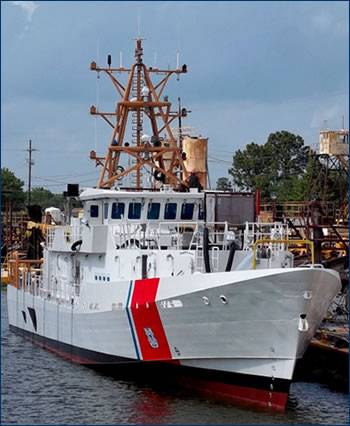
Fast Response Cutter under construction.
The Coast Guard awarded a $179.7 million contract option to Bollinger Shipyards of Lockport, La., September 22 for the production of four more Sentinel-class Fast Response Cutters (FRCs). This option award brings the total number of FRCs under contract with Bollinger to twelve, with a current contract value of $597 million. The current FRC contract contains options for up to 34 cutters and is worth up to $1.5 billion if all options are exercised. The FRCs acquired under this contract option are scheduled to be delivered to the Coast Guard in 2014 and homeported in Key West, Fla..
In September 2008, the Coast Guard awarded Bollinger an $88 million production contract for the lead FRC. That ship, named the Bernard C. Webber, was launched on April 21 and will undergo sea trials prior to its anticipated delivery later this year. The second FRC, Richard Etheridge, was successfully launched August 18, and production is underway on FRCs #3-8. Webber will be homeported in Miami, Fla., and will primarily perform missions to save lives, enforce U.S. and international maritime law and ensure security in the Coast Guard’s 7th District off the Southeastern coast of the U.S. and in the Caribbean Sea.
The Sentinel-class will eventually replace the Coast Guard’s venerable Island-class 110-foot patrol boat. The FRC uses a proven, in-service parent craft design based on the Damen Stan Patrol 4708. It has a required flank speed of 28 knots and will be armed with one stabilized, remotely-operated 25mm chain gun and four crew-served .50 caliber machine guns. Other requirements include the ability to perform independently for a minimum of five days at sea and capable of underway operations for a minimum of 2,500 hours per year. It will use state-of-the-market command, control, communications and computer technology that will be interoperable with the Coast Guard’s existing and future assets, as well as Department of Homeland Security and Department of Defense assets. The cutter will also meet American Bureau of Shipping design, build and class standards. The Coast Guard plans to acquire up to 58 FRCs.


